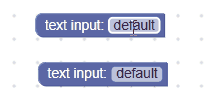একটি টেক্সট ইনপুট ক্ষেত্র একটি স্ট্রিংকে এর মান হিসাবে এবং একটি স্ট্রিং এর পাঠ্য হিসাবে সংরক্ষণ করে। এটির মান সর্বদা একটি বৈধ স্ট্রিং, যখন এটির পাঠ্যটি এটির সম্পাদকে প্রবেশ করা যেকোনো স্ট্রিং হতে পারে।
পাঠ্য ইনপুট ক্ষেত্র

সম্পাদক খোলা সহ পাঠ্য ইনপুট ক্ষেত্র

ধসে পড়া ব্লকে পাঠ্য ইনপুট ক্ষেত্র

সৃষ্টি
JSON
{
"type": "example_textinput",
"message0": "text input: %1",
"args0": [
{
"type": "field_input",
"name": "FIELDNAME",
"text": "default text",
"spellcheck": false
}
]
}
জাভাস্ক্রিপ্ট
Blockly.Blocks['example_textinput'] = {
init: function() {
this.appendDummyInput()
.appendField("text input:")
.appendField(new Blockly.FieldTextInput('default text'),
'FIELDNAME');
}
};
টেক্সট ইনপুট কনস্ট্রাক্টর একটি ঐচ্ছিক মান এবং একটি ঐচ্ছিক যাচাইকারী নেয়। মান একটি স্ট্রিং কাস্ট করা উচিত. এটি null বা undefined হলে, একটি খালি স্ট্রিং ব্যবহার করা হবে।
JSON সংজ্ঞা আপনাকে বানান পরীক্ষা বিকল্প সেট করার অনুমতি দেয়।
সিরিয়ালাইজেশন এবং এক্সএমএল
JSON
একটি পাঠ্য ইনপুট ক্ষেত্রের জন্য JSON দেখতে এরকম দেখাচ্ছে:
{
"fields": {
"FIELDNAME": "text"
}
}
যেখানে FIELDNAME হল একটি স্ট্রিং যা একটি টেক্সট ইনপুট ক্ষেত্রের উল্লেখ করে এবং মান হল ক্ষেত্রে প্রয়োগ করা মান। মানটি কনস্ট্রাক্টর মান হিসাবে একই নিয়ম অনুসরণ করে।
এক্সএমএল
একটি টেক্সট ইনপুট ক্ষেত্রের জন্য XML দেখতে এরকম দেখাচ্ছে:
<field name="FIELDNAME">text</field>
যেখানে ক্ষেত্রের name বৈশিষ্ট্যে একটি স্ট্রিং রয়েছে যা একটি পাঠ্য ইনপুট ক্ষেত্রের উল্লেখ করে এবং ভিতরের পাঠ্যটি ক্ষেত্রে প্রয়োগ করার মান। অভ্যন্তরীণ টেক্সট মান কনস্ট্রাক্টর মান হিসাবে একই নিয়ম অনুসরণ করে।
কাস্টমাইজেশন
বানান পরীক্ষা
ক্ষেত্রটি তার ইনপুট পাঠ্য বানান পরীক্ষা করে কিনা তা সেট করতে setSpellcheck ফাংশন ব্যবহার করা যেতে পারে।
বানান পরীক্ষা সহ এবং ছাড়া পাঠ্য ইনপুট ক্ষেত্র

বানান পরীক্ষা ডিফল্টরূপে চালু আছে।
এটি পৃথক ক্ষেত্রে প্রযোজ্য। আপনি যদি সমস্ত ক্ষেত্র পরিবর্তন করতে চান তাহলে Blockly.FieldTextInput.prototype.spellcheck_ বৈশিষ্ট্য পরিবর্তন করুন।
একটি পাঠ্য ইনপুট যাচাইকারী তৈরি করা হচ্ছে
একটি টেক্সট ইনপুট ক্ষেত্রের মান হল একটি স্ট্রিং, তাই যেকোনো যাচাইকারীকে অবশ্যই একটি স্ট্রিং গ্রহণ করতে হবে এবং একটি স্ট্রিং, null বা undefined প্রদান করতে হবে।
এখানে একটি যাচাইকারীর একটি উদাহরণ যা স্ট্রিং থেকে সমস্ত a সরিয়ে দেয়:
function(newValue) {
return newValue.replace(/a/g, '');
}


